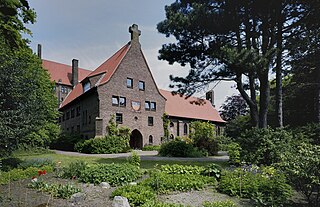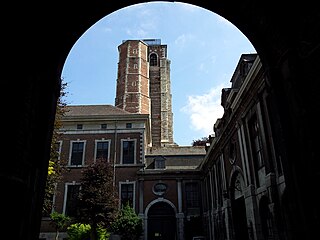
St. Willibrord's Abbey (Dutch : Sint-Willibrordsabdij) at Doetinchem in Gelderland is the most recently established Benedictine monastery in the Netherlands.

St. Willibrord's Abbey (Dutch : Sint-Willibrordsabdij) at Doetinchem in Gelderland is the most recently established Benedictine monastery in the Netherlands.
The monastery, dedicated to Saint Willibrord, was founded immediately after World War II by the over-populated Oosterhout Abbey. Initially the monks lived in Slangenburg Castle, which they partially restored. In the 1950s they succeeded in building a new monastery on part of the castle estate. As building materials were scarce immediately after the war, the monastery was largely built out of old paving stones, and the roofs were constructed without wood: the tiles sit directly on concrete beams.
A large new abbey church was planned, but never materialised: the present church building was originally intended as the monastery library.
The community has a long history of commitment to interreligious dialogue. The retreat house includes a zendo with a rock garden, patterned on the famous Zen gardens of Kyoto. Fr. Cornelius Tholens, abbot from 1954 to 1972, was a founder of the Dialogue Interreligieux Monastique, the European arm of the DIMMID which held its annual meeting here in 2019. [1]

Ruurlo is a village and former municipality in the province of Gelderland in the eastern part of the Netherlands.

Malle is a municipality located in the Campine region of the Belgian province of Antwerp. The municipality comprises the villages of Oostmalle and Westmalle. In 2021, Malle had a total population of 15,620. The total area is 51.99 km2.

The Abbey of Our Lady of Gethsemani is a Catholic monastery in the United States near Bardstown, Kentucky, in Nelson County. The abbey is part of the Order of Cistercians of the Strict Observance, better known as the Trappists. Founded on December 21, 1848, and raised to an abbey in 1851, Gethsemani is considered to be the motherhouse of all Trappist and Trappistine monasteries in the United States. Gethsemani is the oldest Trappist monastery in the country that is still operating.

Susteren Abbey is a former Benedictine abbey at Susteren near Roermond, in the Dutch province of Limburg, founded in the 8th century. The former abbey church is now St. Amelberga's Basilica.

Rolduc is the name of a medieval abbey located on the edge of the town of Kerkrade in the far south-east of the Netherlands. It is today a Roman Catholic seminary with an affiliated conference center. The abbey is a rijksmonument. It features on the official list of 100 top Dutch heritage sites, drawn up in 1990 by what is today the Rijksdienst voor het Cultureel Erfgoed.

The Abbey of Echternach is a Benedictine monastery in the town of Echternach, in eastern Luxembourg. The abbey was founded in the 7th century by St Willibrord, the patron saint of Luxembourg. For three hundred years, it benefited from the patronage of a succession of rulers, and was the most powerful institution in Luxembourg.

Postel Abbey is a Premonstratensian abbey in the Belgian municipality of Mol in the province of Antwerp.

Mill is a village in the south of the Netherlands, located in the municipality of Land van Cuijk, North Brabant. Mill is known from the Battle of Mill, a two-day fight during the German invasion of the Netherlands in 1940. On 1 January 2006, Mill had 6,049 inhabitants and was the capital village of the municipality.

St. Bernard's Abbey, Hemiksem, or abbatiae S. Bernardi ad Scaldim, ordinis Cisterciensis, in dioecesi Antverpiensi also known as St. Bernard's Abbey on the Scheldt, located in Hemiksem in the province of Antwerp in Belgium, was a Cistercian monastery founded in 1243 and dissolved during the French Revolution. The buildings are now the property of the municipality of Hemiksem.

Egmond Abbey or St. Adalbert's Abbey is a Benedictine monastery of the Congregation of the Annunciation, situated in Egmond-Binnen, in the municipality of Bergen, in the Dutch province of North Holland. Founded in 920-925, and destroyed during the Reformation, it was re-founded in 1935 as the present Sint-Adelbertabdij, in the Diocese of Haarlem.

Slangenburg Castle is a castle in the municipality of Doetinchem in the province of Gelderland in the Netherlands. The castle is located in the forest of the same name between the towns of Varsseveld and Doetinchem, about 5 kilometers from the latter.
St. Andrew's Abbey, Bruges was a Benedictine abbey in Sint-Andries, Bruges, Belgium, which was destroyed in the French Revolution. Its modern successor St. Andrew's Abbey, Zevenkerken, founded in 1899–1900, is a Benedictine abbey of the Congregation of the Annunciation.

Sint-Barbaracollege in Ghent, Belgium, is a public Jesuit school, founded in 1833. It currently includes primary and secondary education.

Sint-Truiden Abbey or St Trudo's Abbey is a former Benedictine monastery in Sint-Truiden in the province of Limburg, Belgium. The abbey was founded in the 7th century and was one of the oldest and most powerful in the Low Countries. The town of Sint-Truiden grew up around it. The great Romanesque abbey church, dedicated to Saint Remaclus and Saint Quintin, was demolished in 1798, four years after the suppression of the abbey.

Male Castle, Bruges. A community of the Canonesses Regular of the Holy Sepulchre. It originated in Bruges in the 11th century, and between 1954 and 2013 was settled in Male Castle in Male, Sint-Kruis, Bruges, West Flanders, Belgium.

Koningshoeven Abbey is a monastery of the Trappists founded in 1881 in Berkel-Enschot in North Brabant, the Netherlands.

St. Paul's Abbey, Oosterhout, also Oosterhout Abbey is a former Benedictine abbey in Oosterhout, North Brabant, the Netherlands.
Relations between the Catholic Church and Islam deals with the current attitude of the Catholic Church towards Islam, as well as the attitude of Islam towards the Catholic Church and Catholics, and notable changes in the relationship since the 20th century.

Dendermonde Abbey or the Abbey of Saints Peter and Paul is a Benedictine monastery in Dendermonde (Belgium), which played a role in the Liturgical Movement in Belgium.
DIMMID, Dialogue Interreligieux Monastique - Monastic Interreligious Dialogue (DIM·MID), is a movement within the Benedictine and Cistercian order aimed to promote interfaith dialogue between monastic communities of different religions. Created in 1977, the movement approaches this aim through a mutual understanding and experience of each other's spirituality.
51°57′05″N6°22′03″E / 51.9514°N 6.3675°E